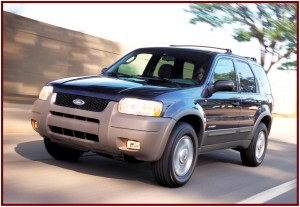
Some of the complaints allege that the failures are related to repairs performed as part of Ford and Mazda safety recalls initiated in 2004 for unintended acceleration.
The National Highway Traffic Safety Administration opened yesterday an unintended acceleration investigation on 2001 through 2004 Ford Escape and Mazda Tribute SUVs after receiving 99 reports of unintended acceleration from owners. At least one fatality and nine injures are alleged in multiple accidents. Almost 730,000 of the best-selling compact SUVs are potentially affected. Sixty-eight stuck throttle reports are from Ford Escape owners; thirty-one reports are from owners of Mazda Tributes.
The Center for Auto Safety last week petitioned NHTSA to open defect investigations on Ford Escape and Mazda Tribute models equipped with cruise control. NHTSA opened its own investigation instead, in a move that was forced given the seriousness of the allegations that were about to become public.
In a defensive bureaucratic move, NHTSA also denied a CAS request for potentially embarrassing public hearings about the safety agency’s, as well as Ford Motor’s and Mazda’s lack of corrective action thus far. To make matters more complicated and even more image damaging for all involved, it is possible that an earlier safety recall resulted in additional unintended acceleration accidents on the models involved.
Some of the stuck throttle complaints, including a fatal crash in January 2012, allege that the failure was caused by interference between the speed control cable and a cover at the throttle body cam. Some of the complaints also allege that the failures are related to repairs performed as part of Ford and Mazda safety recalls initiated in 2004 for unintended acceleration.
The latest safety investigation from NHTSA comes after it requested that Toyota conduct an immediate recall of model year 2010 Lexus RX 350 and RX 450 H vehicles for a serious safety issue involving “potential pedal entrapment by the floor mat,” which in English is also unintended acceleration.
This means that NHTSA was required once again to force Toyota to conduct a recall for unintended acceleration, after NHTSA had previously forced Toyota recalls for the same problem in 2009 and 2010. NHTSA also eventually fined Toyota $50 million for covering up the safety defect, but not before damaging congressional public hearings that showed a lack of concern for the Toyota crashes and deaths at both NHTSA and Toyota.
NHTSA is also requesting additional documentation from Toyota about the latest Lexus problem and is considering opening another investigation into whether Toyota met its obligation to notify the agency and conduct a safety recall in a timely manner. The same obligation exists at Ford and Mazda, of course.
A Ford fire recall is the longest running safety recall in NHTSA history. A defective Texas Instruments speed control deactivation switch (SCDS) may leak, overheat, smoke, and/or burn. Ford engineers did not put a fuse in the circuit, contrary to common industry practice, meaning that full battery amperage was applied when the TI module failed and then caused the unexpected fires, some of them from parked vehicles burning down garages or houses as a result.
Critics maintain that Ford was reluctant to deal with that issue due to the large number of vehicles involved. All told, Ford has now recalled more than 14,000,000 vehicles for the fire problem in the U.S. alone over a ten year period, a record for any single safety defect. Ford Canada also recalled at least 500,000 vehicles for the same fire problem, making it the largest recall in Ford Canada’s history.
Ford is also now in the process of recalling the redesigned 2013 Escape because carpeting can interfere with the accelerator and brake pedals.

